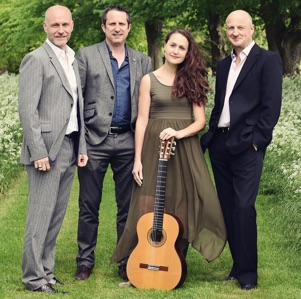ABOUT THE VIDA GUITAR QUARTET:
Celebrating its 15th anniversary this year, The VIDA Guitar Quartet brings together four guitarists of exceptional artistry who share a passion for chamber music: Mark Ashford and Amanda Cook, both internationally renowned performers in their own right, as well as Mark Eden and Christopher Stell, otherwise known as the Eden Stell Guitar Duo, one of the most innovative guitar duos in the world. The Eden Stell Duo performed in Hilo as part of the Hawaii Concert Society’s 2016-17 Season
Since forming in 2007, VIDA has performed to critical acclaim in major UK venues including Kingʼs Place (London), The Purcell room (London), The Sage (Gateshead) and St Georgeʼs (Bristol). They are sought-after festival artists throughout the UK, Europe and North America
In 2011 VIDA made their US débuts in Los Angeles and New York. The quartet has appeared on some of North America’s most prestigious stages for classical guitar. They were chosen as the keynote performers for the 2015 Guitar Federation of America Annual Conference, one of the world’s most high- profile engagements for guitarists. 2017 marked the quartet’s début in China as part of the Changsha International Guitar Festival where they were invited to play the closing night’s concert.
2019 was a busy year for VIDA with extensive tours in the US with concerts in Arizona, Florida, South Carolina and Colorado, and in China performing in concert halls in Shanghai, Shenzhen, Guangzhou, Dalian, Nanchang and Haian.
VIDA are D’Addario string classical artists.
"Vida sparkled with vitality and spontaneity, weaving a rich tapestry of colour and breathtaking range of dynamics and percussive effects that held the audience spellbound ... the visual interplay between them enhancing an already superb performance. These are outstanding musicians. —Acoustic
"Exquisite tonal and dynamic control, super-tight ensemble and unerring musical instinct. Thereʼs only one word for it: magic” —Gramophone
Program Notes (João Luiz):
KHACHATURIAN: Waltz, from Masquerade Suite
Aram Khachaturian was a Soviet Armenian composer and conductor. He wrote Masquerade in 1941 as incidental music for a production of the play of the same name by Russian poet and playwright Mikhail Lermontov. The play tells the story of a world-weary aristocrat who, suspicious of his wife’s adultery, becomes consumed by jealousy, murders her and is driven to insanity upon the revelation of her innocence.
In 1944 Khachaturian extracted five movements to make the well-known symphonic suite, of which the Waltz is the first – and most famous – movement. The waltz accompanies a scene at a masked ball where the play’s heroine, Nina, exclaims “how beautiful the new waltz is … something between worry and joy gripped my heart” – a brief that Khachaturian struggled with. It is at the ball that Nina’s husband’s suspicions are awoken and the music is simultaneously sweeping and beautiful but also rather menacing, hinting at Nina's fate.
BACH: Brandenburg Concerto No. 3 in G major, BWV 1048
Bach was thirty-two when he assumed the position of Kapellmeister at the Court of Prince Leopold of Anhalt in Cöthen in 1717. It was a big decision for the composer, who already had a perfectly good job as orchestra leader for the Duke of Weimar. The Duke refused to accept Bach’s resignation and had him held under arrest for a month before he finally relented and let Bach go.
The allures of Cöthen were substantial. Leopold’s passion for music was boundless, and he was able to offer Bach a professional ensemble of three violinists, a cellist, a double-bassist, two flutists, an oboist, a bassoonist, two trumpeters, a timpanist, an organist, and three singers. Many of Bach’s most buoyant instrumental works date from his years at Cöthen, including the Brandenburg Concertos. The collection was assembled as a sort of job application. In 1721 Bach was in his fourth year as Prince Leopold’s musical director, and everything was going more-or-less swimmingly, but that year the Prince married his cousin, the Princess of Anhalt-Bernburg. She disliked music, and Bach disliked her.
Wishing to escape Cöthen, Bach inscribed a servile dedication letter to Margrave Christian Ludwig of Brandenburg, whom he had met a couple of years before and who he felt might be interested in hiring him. The letter—and the six concertos that accompanied it—seem never to have been acknowledged, and it is all but certain that the Margrave of Brandenburg never had the works performed (he probably couldn’t have, since they call for larger instrumental forces than the Margrave had at his disposal). The name “Brandenburg“ became attached to them nonetheless.
The closing movement, Allegro, is a high-spirited fugue that seems to ask the players to push the tempo to the limit. The first and last movements are connected by a middle movement of merely two chords.
VILLA-LOBOS: Bachianas Brasileiras No. 5
Not until the year after Heitor Villa-Lobos was born did his native Brazil legally abolish slavery. So it's easy to imagine just what an era of revolutionary change was under way as the young composer came of age in Rio de Janeiro. Villa-Lobos absorbed the idioms of the everyday popular music around him as an active participant; for a time he even earned his living by playing cello as a café musician. Already in 1905—a few years before Bartók began his famous ethno-musicological field research—Villa-Lobos had begun collecting examples of folk music in northeastern Brazil. As did Isaac Albéniz, Villa-Lobos loved to spin long, colorful tales out of the actual facts of his excursions (including accounts of his alleged capture by cannibals).
Villa-Lobos also emphasized the non-academic aspect of his approach to composition—this even though he in fact did study at the National Institute of Music in Rio and later even became the architect of a system of music education that has had a profound impact on Brazil's cultural life. "My music is natural, like a waterfall," goes a typical pronouncement.
Villa-Lobos also had fascinating connections to the European tradition—as both exporter of Brazilian idioms (he lived in Paris at various points in his life) and importer of such masters as J.S. Bach, a lifelong idol. The Bachianas brasileiras epitomize the composer's preoccupation with his Baroque predecessor—whom he regarded as "a mediator among all races"—and comprise a widely spanning series of nine suites that he wrote between 1930 and 1945. In their musical content and form as well, the Bachianas brasileiras represent an idiosyncratic meeting ground of Baroque techniques and ideas with the folk and popular musical sources and even folklore from Brazil that were mother's milk for Villa-Lobos.
Bachianas No. 5, the best known of the series, was originally composed for eight cellos (Villa-Lobos's instrument) and soprano, using the voice both for traditional singing and for wordless vocalise. Aria (Cantilena), the first of its two movements, evokes the exquisite, longspun melodiousness of a Bach slow movement; its central section embeds a folksong sensibility into the movement.
ASSAD: Uarekena
Brazilian-born Sérgio Assad, along with his brother and duo partner Odair Assad, is one of today's most important classical guitarists. As a composer, he has made numerous contributions to the repertoire, in addition to inspiring other composers to produce new music for the guitar.
Uarekena is the name and language of a nearly-extinct Indigenous people living in a region that straddles Brazil and Venezuela. (The Indigenous population of Brazil was decimated by diseases brought by European settlement. Many tribes suffered extinction; others were assimilated into the Brazilian population.) Sérgio Assad says that Uarekena "was conceived as a tribute to the resilience of the Brazilian tribes."
The piece was written while Assad was living in Paris. He wrote, "in those days I was really inspired by French impressionism, therefore the piece has some moments that reflect that kind of musical vocabulary."
From the composition's opening, with its repeated notes and pulsing meter, the piece leads listeners on a journey of irregular rhythms, cascading climaxes, and percussive interludes. The compositional techniques include harmonics, improvised lines, tapping with both the right and left hand, and the fourth guitar retuning its sixth string to B. Uarekena was written in 1994 for the Los Angeles Guitar Quartet, and along with Aquarelle, has become one of Assad’s most performed pieces.
BERNSTEIN: Suite from "West Side Story"
The idea for West Side Story was suggested to Leonard Bernstein as early as 1949 by the choreographer Jerome Robbins, who envisioned a modern adaptation of Shakespeare’s classic Romeo and Juliet set in New York City. Bernstein was fascinated with the idea, but he could not find time to work on the project until the mid 1950s. Stephen Sondheim, in his Broadway début, supplied the lyrics, Arthur Laurents wrote the book and Robbins staged the show, which was finally completed in 1957. It was made into a film in 1961 that swept ten Oscars, including Best Picture, and has since entered into the pantheon of the American theater as one of the greatest musicals ever created.
West Side Story was one of the first musicals to explore a serious subject with wide social implications. More than just the story of the tragic lives of ordinary people in a small, grubby section of New York, it was concerned with urban violence, juvenile delinquency, clan hatred and young love. The show was criticized as harshly realistic by some who advocated an entirely escapist function for the musical, depicting things that were not appropriately shown on the Broadway stage. Most, however, recognized that it expanded the scope of the musical through references both to classical literature (Romeo and Juliet) and to the pressing problems of modern society.
In 1961, Bernstein chose a sequence of dance music from West Side Story to assemble as a concert work. He said that he called these excerpts “symphonic” not because they were arranged for full orchestra but because many of them grew, like a classical symphony, from a few basic themes transformed into a variety of moods to fit the play’s action and emotions. The piece opens with a sultry introduction, leading straight into the Mambo and a cadenza that swaggers with all the magnetism of Tony himself. From here, it’s a joyride through the hits of the show; all the favorites are here, including the ebullient “I Feel Pretty.”
(compiled by Lisa Sapinkopf; edited by Tom Geballe)
The Vida Guitar Quartet appears by arrangement with Lisa Sapinkopf Artists, www.chambermuse.com


